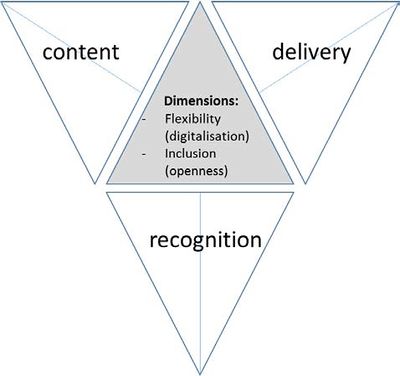Open, online, flexible and technology-enhanced education
Introduction
Open, online, flexible and technology-enhanced education (OOFAT) is a naming of open online education that probably appeared in the 2000's. I could be related to people who associated with technology enhanced learning (TEL).
OOFAT includes Open Educational Resources (OER) and Massive Open Online Courses (MOOCs)
Ebba Ossiannilsson, a distance education and quality specialist, associates OOFAT with open online distance learning
The OOFAT accronym is not exactly one and is spelled out in different ways. E.g. Orr et al. (2018, p. 13) use open, online, flexible provision of technology-enhanced higher education.
Orr, Weller, Farrow OFAT Model
In a report, entitled Models for online, open, flexible and technology enhanced higher education across the globe – a comparative analysis [1], Orr et al. developed a model to encapsulate the three core processes of higher education provision in order to describe, compare and analyse different institutions. The whole report is available under a Creative Commons Attribution-ShareAlike 4.0 International License (CC BY-SA 4.0) and we reproduce parts below.
The three core processes of the ‘OOFAT model’ are (p.8).
- Content – consisting of subject knowledge, support and guidance and learning analytics, which together make up the entirety of all didactical process.
- Delivery – consisting of the qualities of place, pace and timing of delivery of the content; in other words, both the extent of physical and online provision and the question of the timing of key events (e.g. start and end points of learning processes).
- Recognition – consisting of both assessment and credentialization, which are formal processes leading to recognition of learning achievements. Assessment is a phase of evaluation at certain times in a learning process, whilst credentials are awarded on completion of formal learning units. In both cases, these evaluative processes entail a formal endorsement of learning and lead to recognition of achievement of the learner by third parties.
Each of these processes can be analyzed in terms of flexibility and openness:
- Organisational flexibility: The quality of flexibility is a question of “what” and “how” and is likely to rely on how digital technology is harnessed to reduce the need for physical presence; from static to dynamic and changing due to specific circumstances. Each of the three central processes (and their sub-processes) can also be described by the extent to which they are delivered in a flexible manner, harnessing digital technology, i.e. online and technology-enhanced methods.
- Procedural openness: The quality of openness is a “who” question and likely to rely on how the principle of openness is integrated (in various ways) into the core processes; from closed group to open network. More open processes mean less limitations on who has access to and who delivers or controls contents, delivery, assessment and recognition. This quality is not reliant on digital technology, but may be enhanced by it. For instance, an open enrolment to higher education provision can be further enhanced through building a digitally-connected network of peers, who can also develop content and assessment together.
On the basis of this framework, their study identified six types of OOFAT implementations found in the 69 institutions they analyzed (p. 10)
- OOFAT at the centre, where OOFAT is not implemented for one specific purpose, or market, but as an integral part of the institution’s overall mission
- OOFAT for organisational flexibility, where OOFAT supports flexibility of higher education provision across all aspects of the conceptual model
- content-focused OOFATmodel, where providers concentrate on the element of content development and delivery specifically
- access-focused OOFATmodel, where access to content and support is set as the focus of OOFAT implementation
- OOFAT for a specific purpose, where OOFAT implementation is developed for one very specific function or market and not right across the institution
- OOFAT for multiple-projects, where very different initiatives are undertaken by the provider, experimenting with different aspects of the OOFAT model and not as part of a unified strategy
Tools
Any educational technology, instructional design model / pedagogic strategy, etc. can be of interest. However, one can image development of specific technical and conceptual components...
VTT Box
- VTT-BOX (Virtual teachers' toolbox), a EU Earasmus project aims to create a special virtual toolbox for teachers as a sophisticated tool for developing Open Online Distance Learning (OODL). According to their [ website] (retrieved May 7, 2019), The teachers’ toolbox is a web-based service for course developers and assists teachers in creating high quality distance learning courses.
- Is a completely new developed tool and does not yet exist in similar way in the teaching landscape
- Offers an innovative agile and unlimited approach
- Aims to support teachers and trainers in course creation
- Addresses teachers (trainers) as target group
- Provides innovation focusing on course creation, quality enhancement and using technology enhanced teaching (in the way of Online Distance learning)
In total, the box includes eight different tools:
- Developing the course structure
- List of (possible) activities
- List of quality criteria (split in thre different items)
- Aid for course evaluation
- Tool for the competency definition
- Tool to create the self-evaluation mandala
- Checklists for the course (evaluation of outcomes, quality enhencement, active learning)
Acknowledgement & and copyright adjustment
Almost the entire section on the OOFAT model was copied from Orr et al. 2018. [1] You can reuse the contents under a Attribution-ShareAlike 4.0 International license.
References
- ↑ 1.0 1.1 Orr, D., Weller, M., & Farrow, R. (2018). Models for online, open, flexible and technology enhanced higher education across the globe–a comparative analysis. International Council for Distance Education. http://oro.open.ac.uk/55299/
